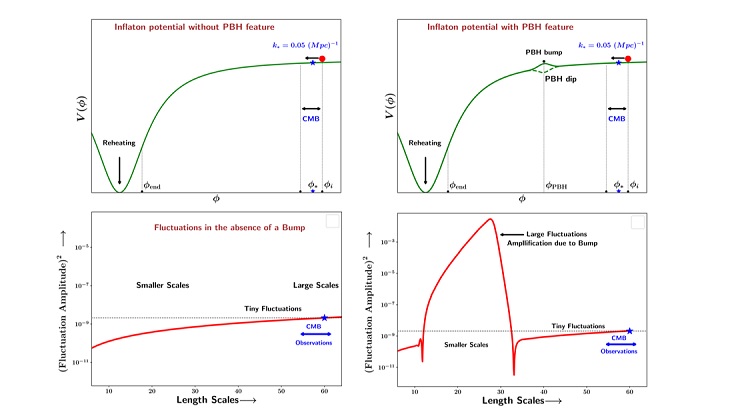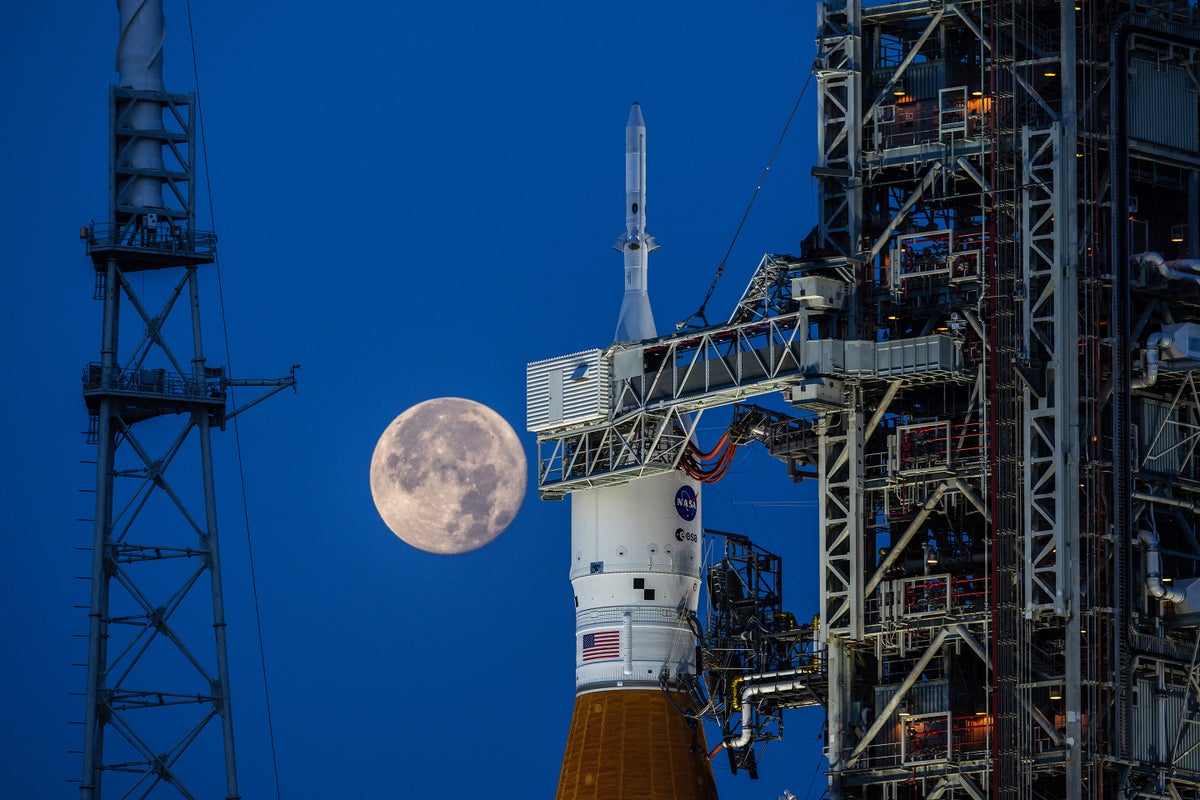Black Holes from the Big Bang - A discussion with Swagat Mishra
-
April 16, 2022
-
918 Views
-
0
Likes
-
Comment
Generating seeds for the formation of Primordial Black Holes during Cosmic Inflation using a tiny speed-breaker Bump/Dip in the inflaton potential.
Can you please describe the broad field of your research?
In Einstein's theory of Gravity, known as General Relativity, Space-time is curved and warped due to presence of matter and energy. Black Holes (BHs) are examples of space-time being almost infinitely curved due to gravitational collapse of matter, usually considered to have resulted due to core collapse of massive stars at the end stages of their lives. We can think of a BH as an extremely dense object being surrounded by a spherical region, known as the event horizon whose size is directly proportional to the mass of the BH. Anything that falls inside the horizon does not come out due to extreme gravitational pull near the BH. Since BHs are usually formed due to collapse of very massive stars, their mass is expected to be greater than 3-5 times the mass of our sun. And hence they form late in our universe, after the formation of the first stars.
We know that our universe, filled with at least 100000 billion billion stars clustered into about 100 billion galaxies today, has been expanding for at least for 13.8 billion years. At early times, universe was hotter and denser. In fact if we go back early enough, to an epoch when the age of the universe was less than 300000 years, it was in a hot dense plasma state. Temperature of the universe was greater than 3000 degrees Celsius, so that atoms could not remain in their neutral state, with electrons having been stripped apart from the nucleus by the presence of high energy photons. Such a hot dense plasma state of our universe, rapidly expanding at early times, is known as the 'Hot Big Bang' phase. The early universe started to cool due to its expansion and once the temperature was small enough, at a time when universe was roughly 380000 years old, neutral Hydrogen (H) and Helium (He) atoms were formed for the first time. The afterglow of this plasma phase, known as the Cosmic Microwave Background (CMB) radiation, has been detected since 1964 and is our most powerful probe of the Early Universe.
The plasma universe also had tiny density (and temperature) fluctuations which got imprinted on the neutral gases after their formation. These tiny density fluctuations were amplified by Gravity, aided by the presence of Dark Matter, over billions of years of evolution -- with initially slightly denser regions forming galaxies and stars etc. Hence it took at least about 1 million years for the first stars to form in the universe and after they finished their lifetime of nuclear burning, they collapsed to form the first Black Holes in the universe. Let us call them Astrophysical BHs.
So it took at least millions of years for the first Astrophysical BHs to form with their masses greater than 3-5 times mass of our Sun. This raises two questions, 1) Could BHs have formed in the Early Universe? 2) Can a BH have mass much smaller than solar mass?
Answer is Yes - 'Primordial Black Holes'

This figure depicts the history of evolution of our universe from early times, when the universe was less than 380000 years old and was in a hot dense plasma state, until the present epoch of 13.8 billions years old universe filled with galaxies and stars as well as Dark Matter and Dark Energy. The seed of all structure in the universe were originated due to quantum jitters in the very early universe created during a phase of exponential expansion of space, known as Cosmic Inflation, which was sourced by the inflaton field acting as a source of repulsive gravity. At the end of this cosmic inflation phase, energy of the inflaton field got converted to all sorts of energetic particles leading to the beginning of the hot dense plasma phase.
Describe what is the problem that you are solving?
Primordial Black Holes (PBHs) are BHs formed in the early universe during the 'Hot Big Bang' phase when universe was much younger than 300000 years old and was dominated by radiation. They can have masses as small as a millionth of a gram to as high as 100000 times mass of our sun.
As described above, Astrophysical BHs (as well as Galaxies and Large scale structure of our universe) were formed due to enhancement of tiny density fluctuations present in the early universe by the action of gravity. The amplitude of these density fluctuations, has been measured as the temperature fluctuations of the CMB radiation by three different Cosmological missions COBE, WMAP and PLANCK with increased level of sensitivity and has been found to be of the order 10^-5. Which means early universe was extremely uniform in density and temperature with tiny variations from place to place, only 1 part in 100000. These fluctuations may be tiny, albeit crucial for structure formation in the universe. In absence of these fluctuations, universe would have been filled with uniform dilute H and He gas today without any stars. However since the fluctuations were tiny, even with the aid of the gravitational pull of dark matter, they took about a million years to form the first stars and subsequently BHs. Hence Astrophysical BHs are formed late in the universe and have a minimum mass of the order of solar mass.
However the situation could have been different if the early universe had rather large density fluctuations, of the order of 1 part in 100. Higher density regions in the early universe with large fluctuations would immediately have collapsed due to gravity, forming BHs without needing the formation of stars first. Since we have already detected the initial fluctuations to be tiny, this raises the natural question 'How could the density fluctuations be large in the Early Universe?' To understand how this could be possible, let us discuss the origin/seed of these density fluctuations, a mechanism called the 'Cosmic Inflation'.
Cosmic Inflation is a short period of exponential expansion of space in the early universe when universe was younger than a billionth of a second (before the commence of the hot plasma Big Bang phase), during which the size of our universe increased by more than a trillion trillion times. Inflation made our universe flat, big and almost uniform. This expansion was fuelled by a metastable energy field which acted as a source of repulsive gravity for a brief period. At the end of Inflation, this energy got converted into all sorts of energetic particles leading to the beginning of the hot Big Bang phase. Quantum physics acting during this inflationary phase led to creation of seeds of tiny density fluctuations which have been detected by the CMB observations on large angular scales ranging from 90 degrees to 1 arc minute.
The problem we were concerned about in this work was -- "Could inflation have created large density fluctuations on smaller angular scales?"
What are the new results from your research?
During inflation, space was filled with a field called the 'Inflaton field'. The energy density associated with this inflaton field could be thought of a combination of its kinetic and potential energy. The situation is almost similar to a ball rolling down a hill, with inflaton field playing the role of the ball and its potential energy playing the roll of the hill. Imagine that the hill is flat at the top and then it sharply falls to create a valley. As long as the ball is around the flat plateau like region on the top, it rolls slowly. Einstein's theory dictates that such a slowly rolling field will create repulsive gravity, exponentially expanding the universe, causing cosmic inflation. However as the ball rolls towards the valley, it begins to speed up, leading to the end of inflation and subsequently oscillating around the central minimum of the valley. The energy of this oscillating field gets converted to particles of our universe and there begins the hot Big Bang phase.
However quantum physics dictates that during the downward journey of the inflaton field, it jitters around. This means at some points in space the field is a little up the hill, while at other parts, it is slightly down. These jitters of the field also creates variations in the time when the inflaton reaches the valley ending exponential expansion of space and eventually beginning the hot plasma phase. The net effect of these random jitters is reflected as the density fluctuations in the subsequent universe. These are the seeds of all structure in our universe.
The amplitude of fluctuations depends on the speed of the inflaton down the potential hill. Smaller the speed, greater the amplitude. Large scale fluctuations were generated when the field was on the top of the hill, while smaller angular scale fluctuations were produced when it rolled towards the valley. In the standard scenario, the hill is smooth and monotonically falls towards the valley, hence the fluctuations on large scales are bigger than that on the smaller scales. Since the observed fluctuations are necessarily tiny (1 part in 10000) on large scales, they are even smaller on small scales, leading to nothing interesting.
However, in this work we discovered that the situation could be dramatically different if there is a tiny bump on the potential hill before the valley (as shown in the figure below). Such a bump acts like a local speed-breaker that temporarily slows down the inflaton field, increasing the quantum jitters on small scales and hence generating seeds of large density fluctuations and later inducing it on the plasma state of the universe. If the amplitude is as high as 1 part in 100, then the radiation plasma in the early universe gets collapsed forming Primordial BHs.
Depending upon the position of the bump on the hill, our model can easily produce both extremely light mountain mass as well as heavy stellar and super-stellar mass PBHs, leaving the observed large scale fluctuations undisturbed.

The left image of the upper panel corresponds to the standard scenario of inflation, in the absence of any bumps on the potential hill. Corresponding quantum fluctuations are shown in the left image of the lower panel which indicates that fluctuations are small on large angular scales while they are even smaller on small scales. Similarly the right image of the upper panel shows the inflaton potential hill with a tiny bump (or a dip) which leads to an amplification of fluctuations at small scales, as depicted in the right image of the lower panel. Such large quantum fluctuations are the seeds for large density fluctuations, leading to Primordial Black Holes formation in the early universe.
Say something about your collaborators who were involved in this research work
This was work was carried out my myself Swagat Saurav Mishra, in collaboration of Prof. Varun Sahni. Prof. Sahni is a Distinguished Professor at the Inter-University Centre for Astronomy and Astrophysics (IUCAA), Pune, India. His research career spans over more than three decades on topics such as Dark Energy, Dark Matter, Structure formation in the universe, Cosmic Web, Cosmic Inflation and Cosmic No-Hair theorem as well as primordial Gravitational Waves.
I am a final year PhD Scholar and Senior Research fellow (CSIR) at IUCAA, Pune, working on theoretical Cosmology under the supervision of Prof. Varun Sahni.
We were working on different models of Cosmic Inflation (different types of smooth Hills) when we got interested in Primordial Black Holes. It is an old research field which has become very active and exciting since 2016 following the discovery of Gravitational Waves from binary BH collisions by LIGO. PBHs could play an extremely important role in explaining the origin of these binary BH systems. They can also seed the super massive BHs at the centre of Galaxies. In fact they can make up a significant fraction of Dark Matter in the universe. As we have discussed above, they can give us important information about the shape of the inflaton potential hill and hence small scale primordial physics. Extremely light PBHs, with mass smaller than the mass of a typical mountain, would have evaporated into radiation by the present epoch in a process called the 'Hawking Radiation'.
We were initially working on several String Theory and Supergravity theory inspired inflaton potentials, which had an intermediate flat plateau-like region in between the top of the potential hill and the valley. These models, popularly known as 'inflection point-like potentials' could only generate very light mass PBHs. Any attempt to generate heavy stellar mass PBHs usually disturbs the already well measured density fluctuations on large angular scales. This problem was generically present in most of the already known models of PBH formation in the scientific literature. However we eventually figured out, following an insight by Prof. Sahni, that the key to this problem was to introduce a tiny local bump, instead of a wide plateau-like feature. When I worked out the details, it turned out that the local speed-breaker could generate PBHs of both light and heavy masses with equal ease without affecting the measured large scale fluctuations. Few weeks later while I was speaking at an International conference, I figured out that even a tiny local dip, in contrast to a tiny bump, can also generate PBHs with the desired mass ranges.
Our paper titled 'Primordial Black Holes from a tiny bump/dip in the Inflaton potential' was published in the 'Journal of Cosmology and Astroparticle Physics' JCAP 04 (2020) 007 (arXiv e-Print: 1911.00057 [gr-qc]) in April 2020. Our paper was featured on Astrobites in December 2019 as well as on Indian news paper 'Indian Express' in April 2020.
What is your future goal?
There are several observational signatures that Primordial Black Holes might have in the universe and many current (as well as future missions) are going to look for their observational imprints. One of the important future direction is to figure out if the binary BH coalescence events that Gravitational Waves detectors such as LIGO and Virgo have detected (or going to detect in the future) are from Astrophysical BHs or Primordial BHs.
Another very interesting area of research that we intend to turn to next is the PBH-associated induced Gravitational Waves from the early universe. As we have learned from the above discussion, that PBHs are formed due to gravitational collapse of radiation in the hot Big Bang phase due to presence of small scale fluctuations of large amplitude. These fluctuations were created by relatively violent quantum jitters during cosmic inflation. In Einstein's theory of gravity, quantum jitters, which create seeds for relatively large density fluctuations, also create large fluctuations in the space-time itself, generating Gravitational waves (GWs). These GWs, known as induced GWs, also peak on similar smaller angular scales where the density fluctuations peak. So their detection, which might be possible with the next generation GWs detectors such as advanced LIGO, LISA, DECIGO, BBO, will be a probe of PBHs as well as small scale physics during cosmic inflation. This is a very exciting and active field of research and we intend to compute the induced primordial GWs in our model with a tiny bump or a dip.

The figure shows images of Gravitational Waves detectors such as LIGO, Einstein's Telescope and LISA which can detect signatures of Primordial Black Holes (PBHs) through Gravitational Waves. The figure also shows the image of SUBARU telescope in Hawaii which can detect PBHs through their gravitational micro-lensing effects.
List of References
Cite this Page as
Keywords
Black Holes
Cosmic Inflation
Primordial Black Holes
Dark Matter
Early Universe
Primordial Gravitational Waves
Big Bang
Cosmology
Astrophysics















